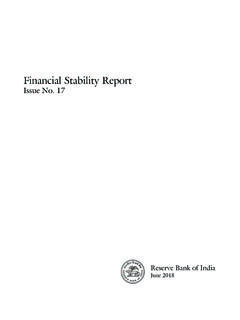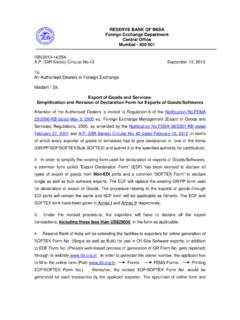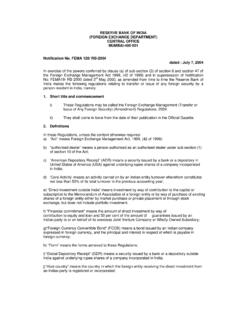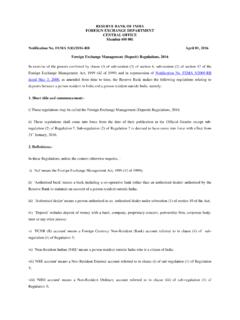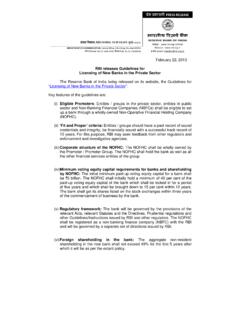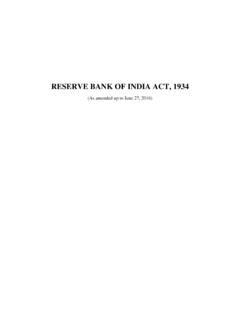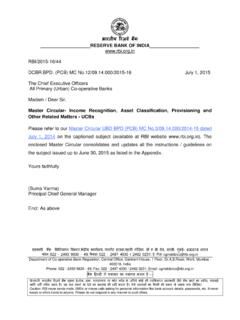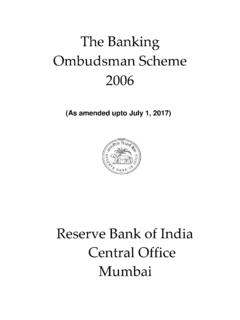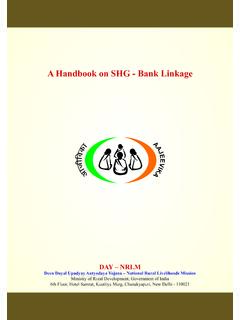Transcription of Recent Developments in India’s Mutual Fund Industry*
1 ArticleRBI Bulletin October 201889 Recent Developments in India s Mutual Fund Industrybeen shifting from physical assets to financial assets and within financial assets, from bank deposits to securities. As investment in capital market instruments involves risks, and individual investors lack expertise with regard to portfolio construction, stock selection and market timing, MFs step in to pool money from a wide cross-section of investors and diversify risk by investing in a portfolio of stocks, bonds and/or money market instruments. These investments are actively managed by professional portfolio managers who undertake strategic transactions to take advantage of current or expected market conditions. In the process, MFs provide a steady flow of income and capital appreciation along with tax benefits to otherwise risk averse lay investors.
2 Not surprisingly, therefore, household preference for MFs over other avenues of investment has increased dramatically since 2016. While the penetration of the MF industry in India, as measured by the AUM/GDP ratio, is still low compared with the global average, favourable demographics, a history of high savings propensity and regulatory reforms brighten the outlook for the industry. In addition, MFs play an important role in equity, debt and money markets as efficient allocators of resources. The debt portfolio of MFs mainly comprises corporate debt instruments, which include floating rate bonds (FRBs), non-convertible debentures (NCDs) and PSU bonds. In the money market segment, MFs are the major lenders in the collateralised borrowing and lending obligation (CBLO) segment, accounting for over 60 per cent of lending in this segment.
3 As major domestic institutional investors, they operate in both primary and secondary segments of the capital market, providing a buffer against market volatility. Against this backdrop, this article attempts to analyse Recent Developments in the Indian MF industry, , up to end-March 2018, with a view to situating it in the changing landscape of financialisation in India. As we show, there are various facets of the industry Mutual fund (MF) industry in India is maturing with broad-basing of investors and increasing geographical spread. MFs in India have become major players in the equity and corporate bond markets and are also providing crucial liquidity support to the money market. Consequently, their influence on price movements in equity and debt markets as also domestic liquidity conditions has increased over time.
4 While the penetration of the MF industry in India, as measured by the Assets under Management (AUM)/GDP ratio, is still low compared with the global average, favourable demographics, a history of high savings propensity and regulatory reforms brighten the outlook for the Recent years, credit intermediation is shifting, with the traditional dominance of the banking sector yielding ground to non- bank intermediaries, including the asset management industry. Within this silent transformation, the MF industry is turning out to be the fastest growing and the most competitive segment of India s financial sector , offering operational flexibility and attractive returns to investors (RBI, 2017). AUM of MFs in India has registered a compound annual growth rate (CAGR) of 25 per cent over the last five years (2013-2018), outstripping the CAGR of only 11 per cent registered by aggregate bank deposits of scheduled commercial banks (SCBs).
5 With growing formalisation and financialisation of the Indian economy, household savings have * This article is prepared by Shri Anand Prakash, Shri Subrat Kumar Seet, Shri Rashmi Ranjan Behera and Shri Abhinandan Borad in the Division of financial Markets of the Department of Economic and Policy Research (DEPR), Reserve bank of India under the guidance of Smt. R. Kausaliya, Adviser, DEPR. The views expressed in this article are those of the authors and do not represent the views of the Reserve bank of Developments in India s Mutual Fund Industry* articleRBI Bulletin October 201890 Recent Developments in India s Mutual Fund Industrythat are less known and even less understood. Our view is that the MFs bridge an important information asymmetry pertaining to investments in the markets and by doing so, they facilitate efficient channelisation of savings, expand investment opportunities, foster market development and catalyse higher investment and growth in the article is structured into four sections.
6 Section II sets out the policy environment in which the Indian MF industry operates, focusing on various regulatory initiatives taken by the Securities and Exchange Board of India (SEBI) in the Recent years to develop the industry. Section III discusses growing financialisation of savings, Recent trends in resource mobilisation by MFs, their investments in equity and debt markets in India and how the industry stacks up in relation to the global MF industry. Section IV provides some concluding The Policy EnvironmentThe origins of MFs in India can be traced back to the second half of the 19th century when the first investment trust - the financial Association of India and China - was formed in 1869.
7 The first Industrial Investment Trust was established in 1933 by M/s Premchand Roychand in Bombay. Many other industrial houses also established trusts, which worked as investment companies and mobilised funds from industrial group companies and promoters. However, a solid foundation for the industry was laid in 1963 with the establishment of the Unit Trust of India (UTI) at the initiative of the Reserve bank of India (RBI) and the Government of India (GoI). It was not until 1987 that new entrants began to shape the evolution of the industry, interspersed with phases of consolidation. According to AMFI1, there are five broad phases of the development of the industry. The first phase (1964-1987) started with the formation of the UTI by an Act of the Parliament and Unit Scheme 1964 (US 64) was the first MF scheme launched by it in 1964.
8 By the end of 1988, UTI had AUM of ` billion. The second phase (1987-1993) marked the emergence of public sector financial companies as MFs, beginning with the establishment of State bank of India (SBI) MF in 1987. Several other public sector banks, the Life Insurance Corporation of India (LIC) and the General Insurance Corporation of India (GIC) also set up their MFs and the industry s AUM reached ` billion by end-1993. With the establishment of the SEBI in 1992 to protect investors interest and to develop and regulate securities markets in India, a new era in the Indian MF industry began in 1993. In the third phase (1993- 2003), private players were allowed to enter the industry and the Indian securities market began to provide Indian investors a variety of MF products.
9 In 1993, SEBI started regulating the MF industry, except UTI, as per SEBI ( Mutual Funds) regulations, 1993, which were comprehensively revised and the new regulations notified in 1996. A number of foreign sponsored MFs came into the market and many mergers took place during this phase. At the end of January 2003, there were 33 MFs with total AUM of `1, billion. The fourth phase (2003-April 2014), which began with the repeal of the UTI Act 1963 in February 2003 and bifurcation of the UTI into a Specified Undertaking of the Unit Trust of India (SUUTI) and the UTI Mutual Fund, witnessed several mergers among private sector funds that led to further consolidation and growth of the MF industry, which was interrupted in the years following the global financial crisis.
10 The fifth phase (May 2014 onwards) witnessed a revival of the industry with steady growth in inflows and AUM, supported by the SEBI s regulatory measures, enhanced reach through better distribution networks and greater investor education. The SEBI has taken various measures in Recent years to establish a comprehensive and credible regulatory regime for the industry, while improving 1 Association of Mutual Funds in Bulletin October 201891 Recent Developments in India s Mutual Fund Industryaccessibility of MF products, re-energising the distribution system, ensuring greater transparency, addressing issues concerning investor protection and awareness. Under the SEBI s initiatives, a new cadre of distributors was formed in September 2012, which includes postal agents, retired government officials, retired teachers and bank officers who were awarded certificates by the National Institute of Securities Markets (NISM) for distribution of simple MF products.

